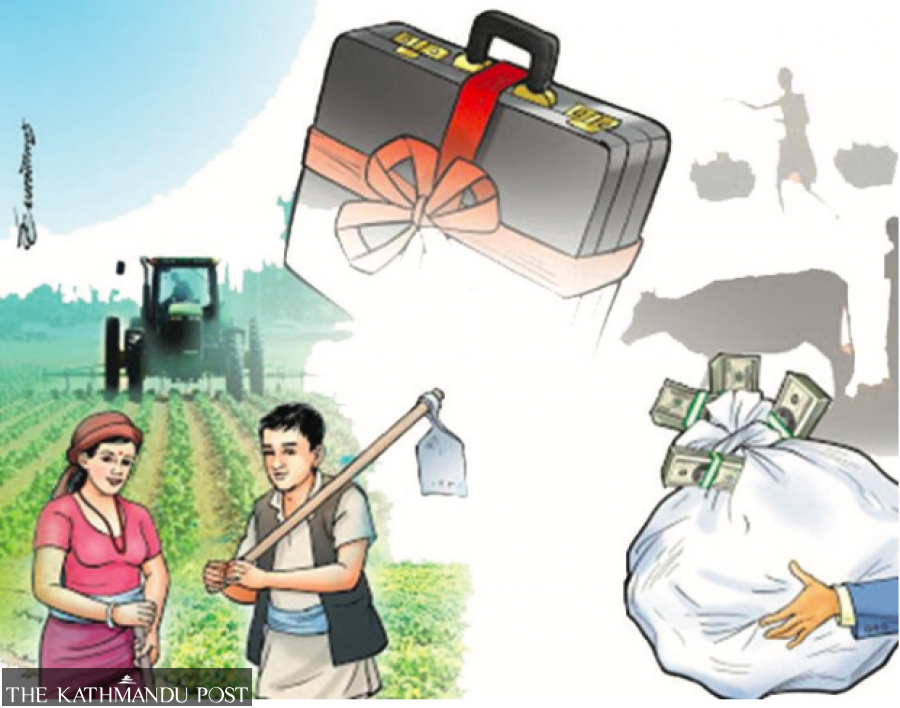Columns
Fiscal and governance issues at local levels
It is vital to address fiscal and administrative challenges for effective governance and service delivery.
Khim Lal Devkota
Local levels provide services by enacting laws and managing fiscal and human resources to perform functions under their exclusive and concurrent rights. As the governments closest to the people, local levels create laws, formulate plans based on local needs and priorities, and efficiently use resources. They operate development projects in a participatory manner, fostering a sense of ownership. Their services include education, health, agriculture, waste management and local dispute resolution.
According to Articles 214 and 221 of the 2015 Constitution, executive and legislative powers at the local level are vested in rural and municipal assemblies. The Local Government Operation Act (LG Act) further outlines responsibilities, including local taxes, basic services, development projects and public welfare. According to Section 102 of the LG Act, local levels can create and implement rules, guidelines, procedures and standards within their jurisdiction. The Auditor General of Nepal's 61st report (OAG report) mentions that the Ministry of Federal Affairs and General Administration provided 52 model laws for local operations. However, the Legislative Management Committee of the National Assembly indicates that it needs six more laws for smooth operation.
The Federation, Province and Local Level (Coordination and Inter-relation) Act 2020 or the Intergovernmental Relations Law (IGR Law) grant local levels the right to make laws within their exclusive and concurrent rights. Despite these provisions, local levels have not enacted the necessary regulations for effective fiscal resource mobilisation, development and service delivery, which has hindered their performance and service delivery.
The IGR Law establishes a Provincial Coordination Council, chaired by the chief minister, to coordinate activities between provinces and local levels in policy coordination, strategic planning, use of shared jurisdiction, and natural resource management. Despite regular meetings, provinces have taken on projects meant for local levels, established redundant provincial offices, and failed to fully transfer funds to local levels. To enhance performance and balance development, provincial governments and local levels must coordinate effectively, holding regular meetings and making decisions to facilitate their tasks under concurrent rights.
Regarding financial status, as stated by the OAG report, in Fiscal Year (FY) 2022-23, the total revenue of the local level was about Rs672 billion, with 86 percent expenditure. Internal revenue, including revenue sharing (VAT and excise duty sharing), contributed 17 percent. Another 17 percent came from cash balance, i.e., the remaining budget from the previous year. The remaining revenue sources are fiscal transfers. The Ministry of Finance claims that revenue sharing and cash balance should also be counted as fiscal transfers, meaning that over 80 percent of local-level revenue comes from fiscal transfers.
In FY 2021-22, the total internal revenue of the local levels was Rs35.75 billion, which declined to Rs33.67 billion in FY 2022-23. This indicates a lack of effort in collecting internal revenue, suggesting heavy dependence on fiscal transfers. In FY 2023-24, local levels received Rs295 billion in grants, which increased to Rs312 billion in FY 2024-25. However, the share of conditional grants rose from 65 percent in FY 2023-24 to 67 percent in FY 2024-25. Despite an overall budget increase of the federal government from Rs1751 billion to Rs1860 billion from FY 2023-24 to FY 2024-25, the unconditional grant to local levels increased by only Rs1 billion. The ratio of fiscal equalisation grants to the total GoN has declined from 14 percent in FY 2018-19 to 9 percent in FY 2024-25.
Local levels have autonomy with fiscal equalisation grants, allowing them to choose programs and projects. However, over 80 percent of conditional grants go towards salaries and expenses for school teachers and other sectoral agency staff. The GoN has been reducing fiscal equalisation grants. The OAG report noted that Rs31 billion in fiscal equalisation grants was deducted towards the end of FY 2022-23. Additionally, a cabinet meeting on January 23, 2024, decided to reduce fiscal equalisation grants to sub-federal levels, including local levels, by 26 percent, amounting to Rs38 billion. This situation is deplorable for the local level. After facing intense criticism from the local level, two days ago, the government decided to release local-level funds, still withholding 7 percent of the necessary amount.
The LG Act mandates internal audits of financial transactions, which, according to the OAG report, 307 local levels have not yet complied. Additionally, most local levels lack periodical development plans and fail to prepare medium-term expenditure frameworks. These frameworks should detail projected expenditures, required allocations, implementation timelines, funding sources, returns and achievements over three years. The failure to follow these requirements impacts the efficiency and transparency of local financial management.
According to the law, local levels must submit their budgets by Ashad 10 (June 24). Most local levels, including Kathmandu Metropolitan City (KMC), presented their budgets. KMC presented a budget amounting to Rs25.63 billion. However, dozens of local levels have not submitted their budgets. As stated in the OAG's report, four to five dozen local levels failed to submit their budgets on time from the very beginning.
Legally, budgets must be allocated to specific programmes and projects, not kept in block form. Despite this, 291 local levels reserved Rs7.44 billion in unallocated funds, allowing executives to allocate and spend later, undermining fiscal discipline. This issue also exists at the provincial level. Although not a major issue, it significantly impacts the financial discipline.
Section 83 of the LG Act mandates that local levels analyse their jurisdiction and workload and propose permanent job positions based on organisation and management surveys, with no temporary positions allowed. However, 229 local levels have spent Rs1.53 billion on salaries and allowances by appointing personnel on service contracts without established posts.
68.37 percent of local-level projects are under Rs500,000, while only 7.93 percent are over Rs2 million, indicating a prevalence of small projects. This issue is reflected in federal ministries; for example, the Ministry of Urban Development has 99 projects worth Rs100,000 each, and the Ministry of Physical Infrastructure and Transport has 626 projects worth Rs500,000 each, as reported by Kantipur Daily on June 19, 2024.
Local levels are responsible for providing accessible and quality services. However, service delivery has been ineffective due to unfilled staff positions, inadequate infrastructure and geographical challenges. Approximately 250 local levels lack a chief administrative officer, and the Ministry of Federal Affairs reports a shortage of about 30,000 staff due to delays in passing the Civil Service Bill.
Additional issues include fragmented planning, fund transfers without implementation, overspending on unproductive programs and non-compliance with procurement laws. Ineffective service delivery also results from inadequate reviews of activities conducted at the local level, private sector, partnerships and civil organisations.
Legal provisions exist for financial accountability through public hearings and social audits to ensure transparency and accountability. However, most local levels fail to clarify income and expenditure, performance status and contributions from consumer committees, neglecting public hearings and audits with stakeholders.
Section 112 of the LG Act mandates that local levels create and implement a code of conduct for members and employees, covering transparency, accountability and avoiding conflicts of interest. Most local levels have not complied with this requirement.
According to the OAG's report, seven local levels have not conducted a final audit or supported the auditing system. Additionally, some local levels failed to conduct audits for FY 2017-18 and FY 2021-22. Local levels neglecting the audit process and essential services should face penalties, such as reductions in their equalisation grants. These grants should be transferred to other local levels within the same province, demonstrating effective work and adherence to rules and regulations.
Local levels must address these fiscal and administrative challenges to ensure effective governance and service delivery. Proper coordination with provincial governments, adherence to legal mandates, and a focus on transparency and accountability are essential for improving local governments' performance and trust.




 7.12°C Kathmandu
7.12°C Kathmandu













%20(1).jpg&w=300&height=200)

